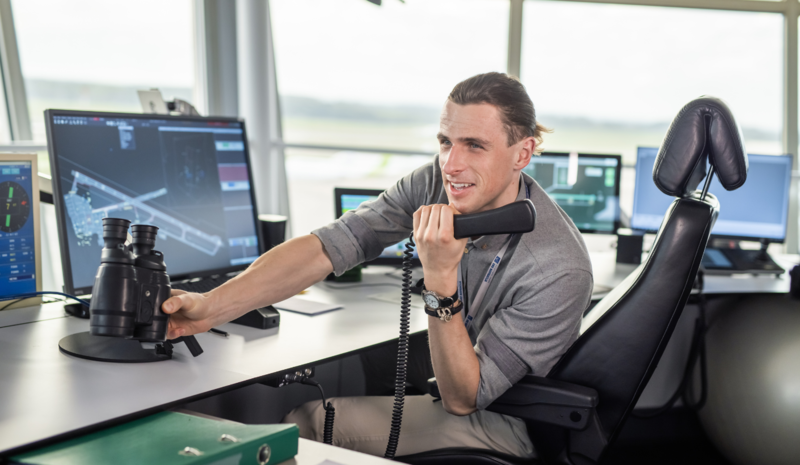Antanas Gustaitis‘ Aviation Institute
Antanas Gustaitis' Aviation Institute
Latest news
Invisible guardians of the sky: How air traffic controllers work

2024-11-14
Invisible guardians of the sky: How air traffic controllers work
A typical action movie scene about airplanes: the pilot desperately tries to control a rebellious aircraft, while air traffic control specialists issue instructions, searching for ways to safely land.
It is these specialists who monitor the skies around the clock, and their decisions sometimes determine the lives of thousands of people — within the airspace controlled by an air traffic controller, there can be up to 20 planes at once, each with over 100 passengers on board.
We invite you to learn more about this profession, as explained by Edgaras Steckis, a lecturer at the VILNIUS TECH Antanas Gustaitis Aviation Institute (AGAI).
Constantly monitoring the sky
“The work of air traffic controllers starts from the ground, with the majority of responsibility falling on their shoulders when the aircraft is on the runway — the key here is to prevent any collisions. That’s why air traffic controllers often say: ‘Our eyes are watching your flight.’ And this monitoring happens 24/7, every day. They have to work on birthdays, during Christmas, and on New Year’s Eve,” says Steckis.
Currently, there are 92 air traffic controllers working in Lithuania. About 10 people work at the Palanga, Siauliai, and Kaunas airports, more than 20 at Vilnius Airport, and over 30 people at the Regional Center, which manages transit traffic over Lithuania.
Not a job for everyone
Air traffic controllers must be in good physical and psychological condition to carefully track the aircraft's position in the airspace — although it may seem boundless to the average person, aviation airspace is divided into many sections that are monitored by the specialists. Moreover, the job requires logical thinking, the ability to orient oneself in 3D space, and most importantly, the ability to quickly respond to a developing situation and choose the best solution.
“Every day is filled with situations where the air traffic controller prevents collisions between aircraft, because this is the main task and function of their job. Often, pilots on the plane are unaware of such situations because controllers work with internal restrictions and standards that are understood in the workplace. This is normal because everyone is doing their part,” explains Steckis.
Dr. Anrieta Dudoit, a VILNIUS TECH AGAI alumna and air traffic controller, describes her work as constantly changing and requiring ongoing learning. "Aviation is a dynamic, evolving, and multifaceted science, so to understand certain things, processes, and situations — especially their deeper meaning and interconnections — one must constantly study, delve deeper, and keep learning. I can confidently say that working in aviation requires continuous knowledge and skill maintenance — not only for air traffic controllers and pilots but also in other related fields, such as air navigation service provider maintenance,” she says.
It is these specialists who monitor the skies around the clock, and their decisions sometimes determine the lives of thousands of people — within the airspace controlled by an air traffic controller, there can be up to 20 planes at once, each with over 100 passengers on board.
We invite you to learn more about this profession, as explained by Edgaras Steckis, a lecturer at the VILNIUS TECH Antanas Gustaitis Aviation Institute (AGAI).
Constantly monitoring the sky
“The work of air traffic controllers starts from the ground, with the majority of responsibility falling on their shoulders when the aircraft is on the runway — the key here is to prevent any collisions. That’s why air traffic controllers often say: ‘Our eyes are watching your flight.’ And this monitoring happens 24/7, every day. They have to work on birthdays, during Christmas, and on New Year’s Eve,” says Steckis.
Currently, there are 92 air traffic controllers working in Lithuania. About 10 people work at the Palanga, Siauliai, and Kaunas airports, more than 20 at Vilnius Airport, and over 30 people at the Regional Center, which manages transit traffic over Lithuania.
Not a job for everyone
Air traffic controllers must be in good physical and psychological condition to carefully track the aircraft's position in the airspace — although it may seem boundless to the average person, aviation airspace is divided into many sections that are monitored by the specialists. Moreover, the job requires logical thinking, the ability to orient oneself in 3D space, and most importantly, the ability to quickly respond to a developing situation and choose the best solution.
“Every day is filled with situations where the air traffic controller prevents collisions between aircraft, because this is the main task and function of their job. Often, pilots on the plane are unaware of such situations because controllers work with internal restrictions and standards that are understood in the workplace. This is normal because everyone is doing their part,” explains Steckis.
Dr. Anrieta Dudoit, a VILNIUS TECH AGAI alumna and air traffic controller, describes her work as constantly changing and requiring ongoing learning. "Aviation is a dynamic, evolving, and multifaceted science, so to understand certain things, processes, and situations — especially their deeper meaning and interconnections — one must constantly study, delve deeper, and keep learning. I can confidently say that working in aviation requires continuous knowledge and skill maintenance — not only for air traffic controllers and pilots but also in other related fields, such as air navigation service provider maintenance,” she says.
-
- Page administrators:
- Linas Vaitonis
- Laurynas Šišovas
- Virginija Leonavičiūtė
- Karolina Kardokaitė
- Ugnė Daraškevičiūtė


